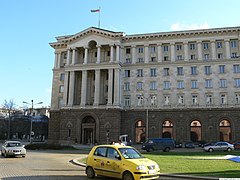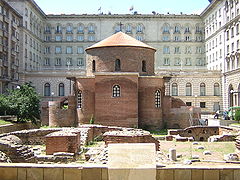Largo, Sofia
| Largo | |
 View of the Largo from the west | |
| Native name | площад „Независимост“ (Bulgarian) |
|---|---|
| Type | Public square |
| Length | 200 m (660 ft) |
| Width | 50 m |
| Location | Sofia, Bulgaria |
| Coordinates | 42°41′52″N 23°19′23″E / 42.69778°N 23.32306°E |
| Construction | |
| Completion | 1955 |
The Largo (Bulgarian: Ларго, definite form Ларгото, Largoto) is an architectural ensemble of three Socialist Classicism buildings around Independence Square (Bulgarian: площад „Независимост“) in central Sofia, the capital of Bulgaria. It was designed and built in the 1950s with the intention of becoming the city's new representative centre. Today it is regarded as one of the prime examples of Socialist Classicism architecture in Southeastern Europe,[1] as well as one of the main landmarks of Sofia.
The Largo complex consists of three buildings around Independence Square: The Council of Ministers and the TSUM department store on the north side, the National Assembly (former Communist Party headquarters) with its iconic spire on the east side, the Presidential Administration (former Council of State) and the Balkan Hotel to the south side. Plans for a 16-storey City Hall on the east side, resembling the Moscow State University main building, were not carried out following de-Stalinisation.[2]
History
[edit]The yellow-cobblestoned square around which the ensemble is centred is called Independence Square. It is formed by the Knyaz Aleksandar Dondukov Boulevard and Tsar Osvoboditel Boulevard merging from the east to continue as Todor Aleksandrov Boulevard west of the Largo. Originally, the square was named after Lenin. A Council of Ministers of Bulgaria decree was published in 1951 regarding the construction of the Largo.[3] The lot in the centre of the city, damaged by the bombing of Sofia in World War II, was cleared in the autumn of 1952, so that the construction of the new buildings could begin in the following years.[3]
The Party House building, once crowned by a red star on a pole, was designed by a team under architect Petso Zlatev and completed in 1955.[3] The building of today's Presidential Administration and Balkan Hotel, the work of Petso Zlatev, Petar Zagorski and other architects, was finished the following year, while today's Council of Ministers and TSUM part of the edifice, designed by a team under Kosta Nikolov, followed in 1957.[3] The fountain between the Presidential Administration and the older National Archaeological Museum was shaped in 1958.[3] The Largo also once featured a statue of Vladimir Lenin, which was later removed and replaced by the one of St. Sophia in 2000.
Refurbishment
[edit]
Following the democratic changes after 1989, the symbols of communism in the decoration of the Largo were removed, with the most symbolic act being the removing of the red star on a pole atop the former Party House using a helicopter and its substitution by the flag of Bulgaria. In the 1990s there have been suggestions to reshape the former Party House, sometimes regarded as an imposing remnant of a past ideology,[4] by introducing more modern architectural elements.[5]
According to the new architectural plan of Sofia, Independence Square is as of 2006[update] being reorganized. The lawn and the flags in the centre are replaced by glass domes, so that the ruins of the ancient Thracian and Roman city of Serdica can be exposed in an impressive way, thus becoming a tourist attraction.[6] The two underpasses, the one in front of the former Party House and the one with the medieval Church of St Petka, are also connected[6] to ease the access to the nearby Serdika and Serdika II metro stations.
Gallery
[edit]-
The former Party House in 1984, before the removal of the red star on spire
-
The former Party House in 2006
-
Council of Ministers
-
Presidential Administration
-
TZUM department store
-
The 4th-century St George Rotunda behind the Balkan Hotel
-
Presidential Guard
References
[edit]- ^ "Bulgaria Sofia Sights Around the Center of the Capital". monkeytravel.org. Archived from the original on February 27, 2006. Retrieved 2006-09-30.
- ^ Stara Sofia (Old Sofia)
- ^ a b c d e Kiradzhiev, Svetlin (2006). Sofia 125 Years Capital 1879-2004 Chronicle (in Bulgarian). Sofia: IK Gutenberg. ISBN 954-617-011-9.
- ^ Todorov, Petar; Mihail Konstantinov (2001-01-10). "Glass Dome Project". Demokratsiya. Archived from the original on 2011-07-06. Retrieved 2006-09-30.
- ^ Panchev, Lyubomir (2006-08-19). "Pro and con the reorganization of the Party House" (in Bulgarian). Duma. Archived from the original on September 29, 2007. Retrieved 2006-09-30.
- ^ a b Aleksandrova, Nina (2006-09-04). "The Largo is to be covered by a glass lid" (in Bulgarian). Standart News. Archived from the original on 2007-09-30. Retrieved 2006-09-30.







